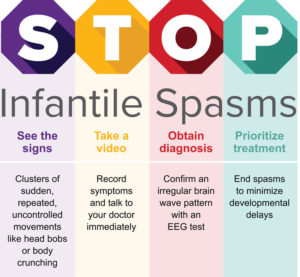What is the Relationship between LGS and Infantile Spasms?
What Are Infantile Spasms?
Infantile Spasms (IS) are a medical emergency. Infantile spasms are a rare but very serious type of seizure. Infantile spasms are caused by a condition in a baby’s brain and include repetitive but often subtle movements—such as jerking of the mid-section, dropping of the head, raising of the arms, or wide-eyed blinks. IS can be misdiagnosed as colic, reflux, or a startle reflex.
Watch this video to see what IS may look like:
Spasms can be mistaken for startle reflex or colic but are, in fact, a much more serious neurological condition. If a timely diagnosis does not occur and medical intervention is delayed, IS can have devastating consequences and can lead to LGS.
Know the signs and know what to do if you suspect iS
- Identifying spasms is critical for parents, caregivers, and providers.
- Because infantile spasms can be mistaken for other conditions or seen as not harmful, prompt diagnosis and appropriate treatment are critical for the child’s best developmental outcome.
- Most pediatricians will only see one or two IS cases throughout their careers.
- A qualified child neurologist can help confirm a diagnosis.
- If a parent or caregiver is concerned that Infantile Spasms have been overlooked, they need to broach the subject directly with their health care provider.
- The earlier a child is diagnosed, the greater the chances that the spasms can be treated.
- Once the spasms are treated, a child’s brain has more time to recover and gain developmental ground that may have been lost while the spasms occurred.
- Many children respond well to treatment and go on to develop normally for their age.
This helpful mnemonic tool—a memorable acronym—calls to mind “STOP Infantile Spasms:
- See the signs: Clusters of sudden, repeated, uncontrolled movements like head bobs or body crunching.
- Take a video: Record the symptoms and talk to your doctor immediately.
- Obtain diagnosis: Confirm an irregular brain wave pattern with an EEG test.
- Prioritize treatment: End spasms to minimize developmental delays
Know the signs to ‘STOP’ Infantile Spasms. Identifying spasms is critical for parents, caregivers, and providers.


Raising awareness of IS is critical
- We need more research on infantile spasms.
- Between 20% – 62% of individuals with LGS have a history of infantile spasms.
- We hope that increased awareness of IS, more timely diagnoses, and immediate medical intervention can prevent infantile spasms from developing into Lennox-Gastaut Syndrome.
HELP US RAISE AWARENESS OF INFANTILE SPASMS
The information here is not intended to provide diagnosis, treatment, or medical advice and should not be considered a substitute for advice from a healthcare professional. The content provided is for informational purposes only. LGSF is not responsible for actions taken based on the information included on this webpage. Please consult with a physician or other healthcare professional regarding any medical or health related diagnosis or treatment options.
Updated 11/14/24 (AM)
